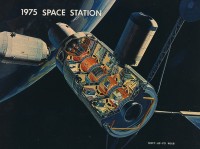In the 1966-1967 period, NASA began serious planning for its post-Apollo future. Alas, Apollo was widely seen as a means of demonstrating U.S. technological might on the world stage, not as a first small step beyond Earth. Our society’s rapid abandonment of the moon causes me to question whether we have every truly qualified as a spacefaring people.
Had it been otherwise, what pathway might NASA have followed into the future? There were many possibilities, but in my forthcoming book I will describe in detail only three. I call these “moon base,” “space base,” and “flyby.” All might have led to humans on Mars in the 1980s, though in none of them was this a requirement. A lot would depend on knowledge gained as NASA moved along the pathways.
NASA planners expected that, after a few early Apollo missions, advanced lunar missions in the Apollo Applications Program (AAP) would commence. These would lead by the mid-1970s to two-week lunar-surface stays. Some of these expeditions would have taken astronauts to the lunar Farside, where relay satellites in Earth-moon L2 Halo Orbit would have linked them with Earth. Others would have surveyed potential outpost and base sites.
By 1980, a space tug – a new upper stage for the Saturn V rocket – would have transported crews directly from Earth to the moon. Some tugs might have established a lunar-orbital way station (image at top of post). Others would have carried surface base modules and supplies. By 1985, humankind’s first permanent base on another world would have been established.
Space tugs might have gone on to serve as propulsion stages for piloted voyages to Mars. Perhaps lunar-produced liquid oxygen would have combined in the space tug engines with liquid hydrogen launched from Earth to propel astronauts beyond the moon.
That was the “moon base” pathway. The “space base” pathway would also have grown from AAP, though not from planned AAP lunar missions. NASA planners expected to launch increasingly sophisticated AAP space stations into Earth orbit beginning as early as late 1968. By 1975, NASA might have used a Saturn V rocket to boost a single-launch space station for from six to 12 astronauts into Earth orbit.
At the end of the 1970s decade, modules based on the single-launch station design could have been joined together to form a nuclear-powered Space Base with a crew of from 50 to 100 people. The Space Base might have revolved to provide its inhabitants with artificial gravity. Fully reusable space shuttles (or other logistics spacecraft – engineers proposed alternatives) would have rotated crews, delivered supplies, and returned experiment results and (possibly) space-made products to Earth.
An intensive Earth-orbital program might have yielded specialized Space Bases – for example, zero-gee hospitals and assembly bases for Solar Power Satellites. Or, just possibly, a space base might have been fitted out with nuclear-electric thrusters – beefed-up versions of thrusters used to maintain the Space Bases in their orbits about the Earth – and relocated to Mars orbit. Space Base components might also have been combined in new ways to build a large Mars ship.
The “flyby” pathway would also have grown from AAP space stations, but would have aimed directly for Mars at an early date. A flyby spacecraft with only enough modifications to enable it to serve as an Earth-orbital station would have been launched into Earth orbit as early as 1972. On board, astronauts would have simulated a two-year piloted Mars flyby mission and tested equipment while they monitored their own health and performance during the long stay in space.
If the Earth-orbital test was a success, then a second flyby spacecraft outfitted for interplanetary travel was expected to leave Earth orbit on a free-return path in September 1975. As it passed Mars, its crew would have released robotic probes, including sample collectors, which they would have operated on Mars by remote control. The 1975 flyby spacecraft would have passed through the inner Asteroid Belt before falling back to Earth.
NASA might have taken advantage of opportunities for a Venus-Mars-Venus flyby starting in 1977 and a Venus-Mars flyby starting in 1979. The experience gained through these relatively cheap combined human-robotic missions could have led to a “minimum-energy” Mars landing mission as early as 1981. Mars landings might have occurred every 26 months throughout the 1980s. By the end of that decade, an operational Mars refueling station – perhaps on the martian moonlet Deimos – would have permitted NASA to establish a permanent Mars base.
NASA planners expected that the “moon base” and “space base” pathways would in their early years have required NASA budgets of about $5 billion per year adjusted for inflation, rising to about $9 billion per year by 1980. The “flyby” pathway would have been cheaper; it would have called for a NASA budget through 1980 of about $5 billion per year adjusted for inflation. Perhaps two-thirds of these NASA budget totals would have gone toward piloted spaceflight programs; the remainder would have supported NASA’s other programs, such as aeronautics research.
To place these costs in perspective: $5 billion per year, equivalent to NASA’s peak Apollo-era budget in Fiscal Year 1965, amounted to about 1% of the Federal budget. By 1968, the war in Indochina cost about $5 billion every 75 days. The entire Apollo Program from 1961 to 1972 cost a little less than $25 billion (it came in under budget).
The upshot of this is, these proposed space programs would have been remarkably cheap and might have delivered results that seem today like science fiction. Only an intense myopia – nearly a medieval belief that the universe revolves around the Earth, or that the sky is a painted dome – prevented us a half-century ago from seeing the boundless frontier around us. Only the same myopia – which, if anything, has grown worse – prevents us from seeing it now.
 Yaspan Tech, Computers, Gadgets, Reviews, News and Analysis
Yaspan Tech, Computers, Gadgets, Reviews, News and Analysis






